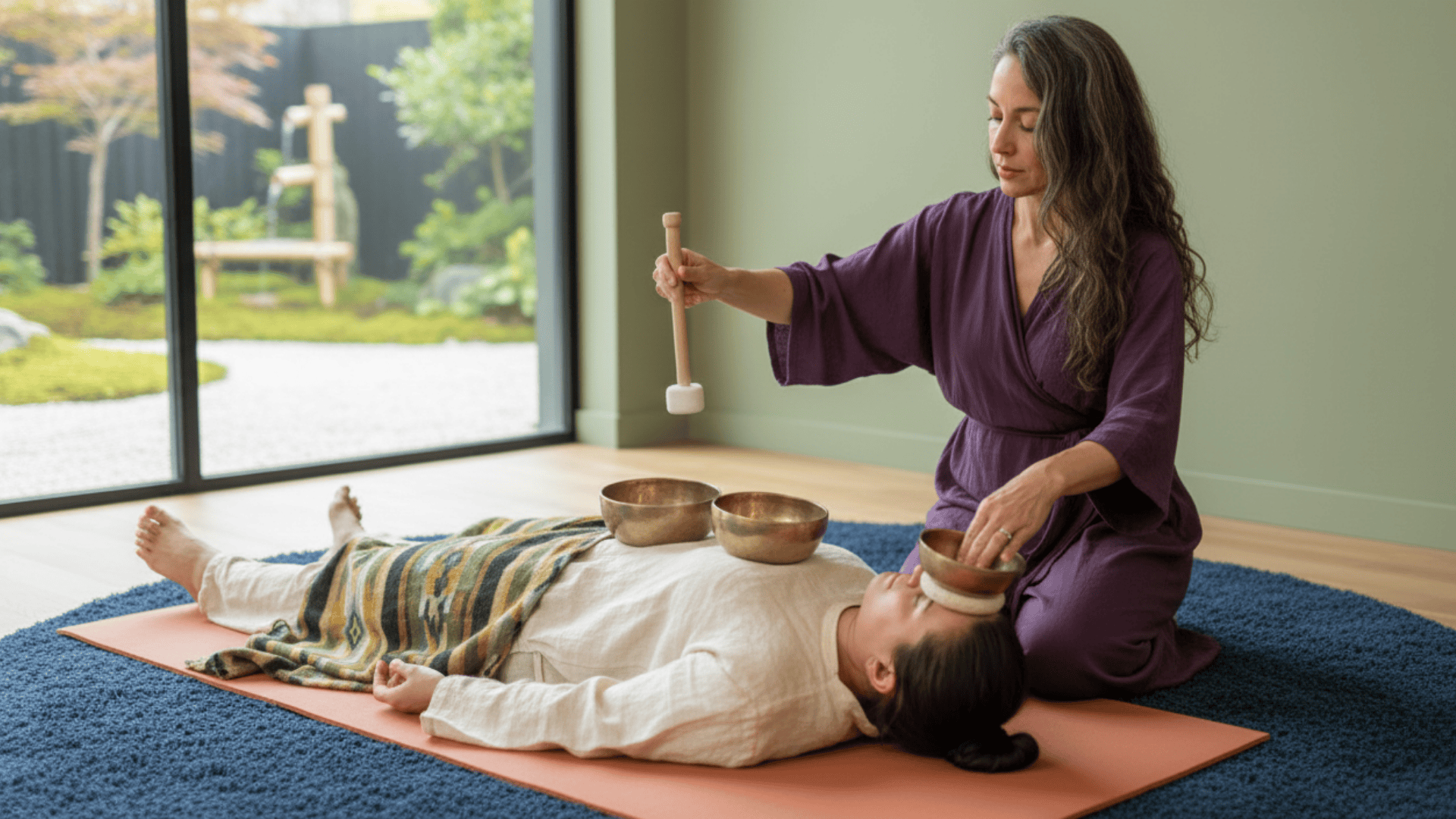When I first heard about sound healing training, I was curious how simple vibrations could calm the body and mind.
If you’ve been wondering the same, you’re not alone in that curiosity. These programs combine ancient practices with modern science, teaching you how to utilize bowls, gongs, and tuning forks to reduce stress and achieve balance.
In this blog, I’ll share what I’ve learned about training options, costs, and career paths so you can decide what’s right for you. My goal is to give you everything you need to take the next step with confidence.
What is Sound Healing Training?
Sound healing training teaches you how to use instruments like singing bowls, gongs, and tuning forks to help people relax and reduce stress.
These programs blend ancient wisdom with modern science, offering professional sound healing certification and showing how vibrations affect the brain and nervous system. You’ll learn to create safe, effective sessions for individuals and groups.
Core Principles and Foundations: Scientific basis of sound therapy, vibrational medicine, and neuroplasticity research supporting therapeutic sound applications.
Essential Skills Development Timeline
- Months 1-3: Basic instrument techniques and session safety protocols
- Months 4-6: Advanced facilitation skills and client interaction mastery
- Months 7-12: Specialization development and business foundation building
Training covers both practical skills and business knowledge. Most programs teach instrument handling, session planning, client safety, and how to start your own practice.
Do You Need Certification to Be a Sound Healer?

You don’t technically need certification to begin offering sound healing, but accredited training adds credibility, professional structure, and client trust.
Organizations like the International Sound Therapy Association (ISTA) provide recognized certification for practitioners who meet specific training hours.
Regional rules vary; some states or countries require business registration, liability insurance, or even massage therapy licensing if touch is involved. Certification also helps you access insurance, join professional associations, and expand career opportunities.
While self-taught practice is possible, completing an accredited program ensures you have the skills, ethics, and legal protection to work safely and effectively.
Types of Sound Healing Training
Sound healing training is available in multiple formats, each offering unique benefits depending on your schedule, learning style, and goals.
1. Online Programs
Online programs give you flexibility with self-paced lessons, making them affordable and accessible from anywhere. You can learn directly from global instructors, find diverse techniques, and fit training around work or family responsibilities.
While feedback may be limited, these courses are perfect for beginners or professionals seeking foundational skills without travel costs or strict scheduling demands.
2. In-Person Workshops
Workshops provide immersive, hands-on learning with direct feedback from instructors. They allow you to practice with professional-grade instruments, build peer networks, and refine techniques quickly.
This format is ideal if you prefer experiential learning and want accountability.
While usually more expensive and time-intensive than online courses, the real-time corrections and deeper connections developed during workshops often accelerate mastery and improve overall practitioner confidence and safety.
3. Hybrid and Retreat Options
Hybrid programs combine online theory with practical in-person sessions, striking a balance between flexibility and hands-on experience.
Retreat-style intensives often immerse you in a focused environment, combining study with healing practices and peer connection. These programs are especially effective for learners seeking structure but unable to commit full-time.
While costs vary, hybrid and retreat formats often deliver well-rounded instruction by blending academic knowledge with experiential, community-based sound healing practice.
4. Free vs. Paid Learning
Free workshops and online resources provide an easy entry point, letting you explore sound healing basics with minimal investment. However, these options rarely include structured certification or personalized guidance.
Paid programs, on the other hand, offer comprehensive curricula, recognized certifications, and mentorship opportunities.
Choosing between free and paid learning depends on your goals: if you are exploring or pursuing professional practice. Many practitioners begin free, then transition into structured paid training for career development.
Sound Healing Curriculum Overview

A sound healing curriculum blends practical instrument training, scientific foundations, and ethical facilitation, giving you the knowledge to create safe, effective sessions.
1. Instruments and Techniques
Training usually starts with learning to play singing bowls, gongs, and tuning forks, alongside using your voice for toning and chanting. These instruments each carry unique frequencies that influence the body and mind.
Hands-on practice develops your ability to combine sounds into therapeutic sessions, whether working one-on-one with clients or leading immersive group sound baths.
2. Science and History Modules
Courses often include the history of sound healing, tracing ancient practices from different cultures. Modern science is also found, covering physics, vibrational medicine, and neuroscience research that explains why sound influences relaxation and healing.
This combination helps you connect ancient wisdom with evidence-based knowledge, equipping you to explain benefits to clients clearly and confidently.
3. Facilitation and Ethics
Beyond playing instruments, you’ll learn how to guide safe, structured sessions. Training emphasizes ethics, such as setting boundaries, assessing client needs, and ensuring inclusivity.
You’ll also find facilitation skills for leading group sound baths, managing client sensitivities, and creating calming environments. By focusing on safety and professionalism, these lessons prepare you to deliver meaningful experiences without overstepping therapeutic limits.
How Long Does Training Take?
The length of sound healing training varies depending on the program and your goals. Some weekend workshops provide introductory skills, while structured certification programs often span three to six months.
More advanced diploma-level courses can take up to a year, especially if they include mentoring, practicum hours, and business development.
Most accredited certifications require a set number of training hours, typically ranging from 100 to 200.
Your career path also influences the pace; some choose an accelerated six-month transition, while others prefer a gradual year-long approach to build skills, confidence, and a sustainable client practice.
Best Sound Healing Training Programs
Different academies and platforms offer sound healing training, each with unique strengths, costs, and approaches to fit diverse student needs.
1. Sound Healing Academy
The Sound Healing Academy teaches Integral Sound Healing, blending science with holistic practice. Programs include global workshops and online learning, plus advanced business modules.
The academy also includes pathways for sound bath certification, helping practitioners specialize in leading immersive group experiences.
Students benefit from mentorship, hands-on training, and access to a worldwide network of practitioners. This academy is ideal for those seeking research-backed methods, international recognition, and practical business development support.
- Location: Global (HQ in Cornwall, UK)
- Program Focus Areas: Integral Sound Healing, Sound Bath Certification, Business Training
2. Sound Medicine Academy
Sound Medicine Academy provides one of the most affordable entry points, with flexible self-paced programs and accredited certifications.
Students can specialize in areas such as singing bowls, tuning forks, or gong therapy, tailoring their training to personal interests. The flexibility makes it accessible for working professionals or career changers who are balancing multiple responsibilities.
- Location: Online (Global Access)
- Program Focus Areas: Singing Bowls, Gongs, Tuning Fork Therapy, Affordable Accredited Certification
3. Mind Body Music Center
Mind Body Music Center emphasizes a therapeutic, somatic approach to sound healing. Its programs are hands-on and often geared toward healthcare professionals, yoga instructors, and trauma-informed practitioners.
Students receive direct supervision to ensure proper technique and safe practice, making it valuable for clinical and therapeutic applications.
- Location: Asheville, North Carolina, USA
- Program Focus Areas: Somatic Sound Healing, Trauma-Informed Practice, Clinical Applications
4. British Academy of Sound Therapy
The British Academy of Sound Therapy (BAST) is a UK-based leader known for award-winning programs and ongoing research into sound therapy.
Courses cover both practical applications and evidence-based foundations, preparing practitioners for work in wellness, education, or healthcare. With an emphasis on blending creativity, research, and structured training, BAST also offers opportunities to join cutting-edge studies.
- Location: West Sussex, England, UK
- Program Focus Areas: Research-Based Training, Creativity + Therapy Integration, Accredited Diplomas
5. Udemy – Online Sound Healing Courses
Udemy hosts numerous affordable courses for beginners, priced between $20 and $200. Programs cover basics like tuning forks, singing bowls, and foundational sound bath techniques.
While they don’t provide accredited certification or mentorship, they’re ideal for testing your interest before investing in higher-level programs.
- Location: Online (Global Access)
- Program Focus Areas: Entry-Level Sound Healing, Singing Bowls, Tuning Forks, Flexible Self-Paced Learning
Global vs. Local Training Options
Sound healing training differs worldwide, with unique opportunities in the US, UK, and international markets, alongside flexible online programs.
| Region / Format | Key Features | Benefits |
|---|---|---|
| United States | Wide variety of academies, retreats, and certification programs. | Strong market demand, corporate wellness opportunities, and diverse training options. |
| United Kingdom | Research-based academies, such as BAST, offer structured diplomas and recognition. | Highlights include scientific credibility, award-winning programs, and international recognition. |
| International | Retreats and workshops in Asia, Europe, and South America. | Exposure to cultural approaches, immersive learning, and global networks. |
| Online Worldwide | Flexible, self-paced programs accessible from anywhere. | Affordable, diverse instructors, no travel costs, suitable for working professionals. |
| Local Workshops | Community-based studios and small groups. | Affordable, hands-on practice, personal connections, strong peer support, direct feedback. |
Career Pathways After Certification
Sound healing certification opens diverse opportunities depending on your interests and background. Many practitioners build independent practices, offering private sessions and group sound baths.
Others integrate sound therapy into existing fields like yoga, Reiki, massage, or counseling to enhance client experiences. Corporate wellness programs and retreat centers also create demand for trained facilitators, expanding professional options.
Teaching workshops, conducting research, or contributing to wellness education are additional paths for advanced practitioners.
Successful career transitions often involve pre-training financial planning, maintaining a six to twelve-month expense buffer, and following structured timelines to gradually build confidence, skills, and a stable client base.
Science Behind Sound Healing
A growing body of research supports sound healing’s effects on stress reduction and relaxation. Goldsby et al. (2016) found singing bowl meditation reduced anxiety, anger, and depression while boosting well-being.
Saskovets et al. (2025) showed that sound interventions lowered cortisol, heart rate, and blood pressure. A systematic review by Cai et al. (2025) confirmed that Tibetan singing bowls improve psychological health and relaxation.
Seetharaman (2024) highlighted their ability to shift brainwaves into theta and delta states. Matthews et al. (2023) and Cordi et al. (2021) further demonstrated sound’s role in reducing stress and improving sleep quality through neurological modulation.
Choosing the Right Training Program
Select training programs based on learning style, budget, and career goals. Visual learners benefit from video-heavy online courses, while kinesthetic learners need hands-on workshops.
Calculate total investment, including certification fees, equipment costs, travel expenses, and living expenses during practice building. Consider program accreditation, instructor experience, and alumni success rates.
Online programs offer flexibility for working professionals, but they often lack immediate feedback. In-person training offers better technique development but comes at a higher cost.
Hybrid approaches balance both benefits. Match the program focus to your intended specialization – some emphasize business development while others concentrate on therapeutic applications or specific instruments.
Key Takeaways
Now that you’ve seen what sound healing training involves, I hope you feel clearer about where it could fit into your life.
For me, learning about the science, costs, and career paths showed just how practical and rewarding this field can be.
Think about your own goals. Do you want personal growth, a side practice, or a full career? The choice is in your hands. My advice is to start where you feel comfortable and grow from there.
If this inspired you, check out my other blogs for ideas that can guide your next step forward.





